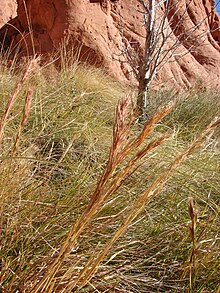Andropogon glomeratus is a species of grass known by the common names bushy bluestem and bushy beardgrass. This bunchgrass is native to the Americas, where it is widespread.[2] It has also naturalized in other areas.
| Andropogon glomeratus | |
|---|---|

| |
| Scientific classification | |
| Kingdom: | Plantae |
| Clade: | Tracheophytes |
| Clade: | Angiosperms |
| Clade: | Monocots |
| Clade: | Commelinids |
| Order: | Poales |
| Family: | Poaceae |
| Subfamily: | Panicoideae |
| Genus: | Andropogon |
| Species: | A. glomeratus
|
| Binomial name | |
| Andropogon glomeratus (Walt.) Britton, Sterns & Poggenb.
| |
| Synonyms | |
|
Andropogon marcrourus Michx. | |
The genus name Andropogon comes from the Greek words 'aner' or 'andros' meaning "man" and 'pogon' meaning "beard", in reference to the hairs on the spikelets of certain species in this genus. The specific epithet glomeratus means "bunched", in reference to the species' bushy and broom-like inflorescences.[3]
Description
editThis grass reaches heights approaching two meters (6 feet) and has large, fluffy cream-colored inflorescences.[4] Each dense, tufted inflorescence has several pairs of hairy spikelets. The leaves may reach over a meter in length and are typically blue-green in the summer and coppery-red in the fall.[2]
Cultivation
editThis plant does best in moist soils, and is found naturally in areas such as swamps, wet savannas, pine flatwoods, bogs, and fens.[5] It prefers full sun, and is best suited to USDA hardiness zones 5–9.[4]
Uses
editIt is cultivated as an ornamental grass. This species also has potential as a noxious weed and is easily spread via seed contamination. It has been declared a weed in Puerto Rico and a potentially invasive weed in Mexico.[6]
The seeds are eaten by songbirds and small mammals, while the larvae of certain butterflies feed on the plant.[7]
References
edit- ^ "NatureServe Explorer". Retrieved 2021-04-30.
- ^ a b "Lady Bird Johnson Wildflower Center - The University of Texas at Austin". www.wildflower.org. Retrieved 2021-04-30.
- ^ "Andropogon glomeratus - Plant Finder". www.missouribotanicalgarden.org. Retrieved 2021-04-30.
- ^ a b "Andropogon glomeratus". hoffmannursery.com. Retrieved 2021-04-30.
- ^ "Andropogon glomeratus (Bushy Bluestem)". Gardenia.net. Retrieved 2021-04-30.
- ^ Quiroz, Diana (November 21, 2019). "Andropogon glomeratus". CABI Invasive Species Compendium. Retrieved April 30, 2021.
- ^ "Andropogon glomeratus (Bluestem, Broomsedge, Bush Beard Grass, Bushy beardgrass, Bushy Bluestem) | North Carolina Extension Gardener Plant Toolbox". plants.ces.ncsu.edu. Retrieved 2021-04-30.
External links
edit- Andropogon glomeratus. Grass Manual Treatment.
- Andropogon glomeratus. Lady Bird Johnson Wildflower Center.
- Andropogon glomeratus. Center for Aquatic and Invasive Plants. University of Florida IFAS.
- Clayton, W.D.; Vorontsova, M.S.; Harman, K.T.; Williamson, H. "Andropogon glomeratus". GrassBase - The Online World Grass Flora. Royal Botanic Gardens, Kew.
